Ying Yang
Kimi K2: Open Agentic Intelligence
Jul 28, 2025Abstract:We introduce Kimi K2, a Mixture-of-Experts (MoE) large language model with 32 billion activated parameters and 1 trillion total parameters. We propose the MuonClip optimizer, which improves upon Muon with a novel QK-clip technique to address training instability while enjoying the advanced token efficiency of Muon. Based on MuonClip, K2 was pre-trained on 15.5 trillion tokens with zero loss spike. During post-training, K2 undergoes a multi-stage post-training process, highlighted by a large-scale agentic data synthesis pipeline and a joint reinforcement learning (RL) stage, where the model improves its capabilities through interactions with real and synthetic environments. Kimi K2 achieves state-of-the-art performance among open-source non-thinking models, with strengths in agentic capabilities. Notably, K2 obtains 66.1 on Tau2-Bench, 76.5 on ACEBench (En), 65.8 on SWE-Bench Verified, and 47.3 on SWE-Bench Multilingual -- surpassing most open and closed-sourced baselines in non-thinking settings. It also exhibits strong capabilities in coding, mathematics, and reasoning tasks, with a score of 53.7 on LiveCodeBench v6, 49.5 on AIME 2025, 75.1 on GPQA-Diamond, and 27.1 on OJBench, all without extended thinking. These results position Kimi K2 as one of the most capable open-source large language models to date, particularly in software engineering and agentic tasks. We release our base and post-trained model checkpoints to facilitate future research and applications of agentic intelligence.
OneSug: The Unified End-to-End Generative Framework for E-commerce Query Suggestion
Jun 07, 2025Abstract:Query suggestion plays a crucial role in enhancing user experience in e-commerce search systems by providing relevant query recommendations that align with users' initial input. This module helps users navigate towards personalized preference needs and reduces typing effort, thereby improving search experience. Traditional query suggestion modules usually adopt multi-stage cascading architectures, for making a well trade-off between system response time and business conversion. But they often suffer from inefficiencies and suboptimal performance due to inconsistent optimization objectives across stages. To address these, we propose OneSug, the first end-to-end generative framework for e-commerce query suggestion. OneSug incorporates a prefix2query representation enhancement module to enrich prefixes using semantically and interactively related queries to bridge content and business characteristics, an encoder-decoder generative model that unifies the query suggestion process, and a reward-weighted ranking strategy with behavior-level weights to capture fine-grained user preferences. Extensive evaluations on large-scale industry datasets demonstrate OneSug's ability for effective and efficient query suggestion. Furthermore, OneSug has been successfully deployed for the entire traffic on the e-commerce search engine in Kuaishou platform for over 1 month, with statistically significant improvements in user top click position (-9.33%), CTR (+2.01%), Order (+2.04%), and Revenue (+1.69%) over the online multi-stage strategy, showing great potential in e-commercial conversion.
Light as Deception: GPT-driven Natural Relighting Against Vision-Language Pre-training Models
May 30, 2025Abstract:While adversarial attacks on vision-and-language pretraining (VLP) models have been explored, generating natural adversarial samples crafted through realistic and semantically meaningful perturbations remains an open challenge. Existing methods, primarily designed for classification tasks, struggle when adapted to VLP models due to their restricted optimization spaces, leading to ineffective attacks or unnatural artifacts. To address this, we propose \textbf{LightD}, a novel framework that generates natural adversarial samples for VLP models via semantically guided relighting. Specifically, LightD leverages ChatGPT to propose context-aware initial lighting parameters and integrates a pretrained relighting model (IC-light) to enable diverse lighting adjustments. LightD expands the optimization space while ensuring perturbations align with scene semantics. Additionally, gradient-based optimization is applied to the reference lighting image to further enhance attack effectiveness while maintaining visual naturalness. The effectiveness and superiority of the proposed LightD have been demonstrated across various VLP models in tasks such as image captioning and visual question answering.
Demystifying the Paradox of Importance Sampling with an Estimated History-Dependent Behavior Policy in Off-Policy Evaluation
May 28, 2025Abstract:This paper studies off-policy evaluation (OPE) in reinforcement learning with a focus on behavior policy estimation for importance sampling. Prior work has shown empirically that estimating a history-dependent behavior policy can lead to lower mean squared error (MSE) even when the true behavior policy is Markovian. However, the question of why the use of history should lower MSE remains open. In this paper, we theoretically demystify this paradox by deriving a bias-variance decomposition of the MSE of ordinary importance sampling (IS) estimators, demonstrating that history-dependent behavior policy estimation decreases their asymptotic variances while increasing their finite-sample biases. Additionally, as the estimated behavior policy conditions on a longer history, we show a consistent decrease in variance. We extend these findings to a range of other OPE estimators, including the sequential IS estimator, the doubly robust estimator and the marginalized IS estimator, with the behavior policy estimated either parametrically or non-parametrically.
Kimi-Audio Technical Report
Apr 25, 2025Abstract:We present Kimi-Audio, an open-source audio foundation model that excels in audio understanding, generation, and conversation. We detail the practices in building Kimi-Audio, including model architecture, data curation, training recipe, inference deployment, and evaluation. Specifically, we leverage a 12.5Hz audio tokenizer, design a novel LLM-based architecture with continuous features as input and discrete tokens as output, and develop a chunk-wise streaming detokenizer based on flow matching. We curate a pre-training dataset that consists of more than 13 million hours of audio data covering a wide range of modalities including speech, sound, and music, and build a pipeline to construct high-quality and diverse post-training data. Initialized from a pre-trained LLM, Kimi-Audio is continual pre-trained on both audio and text data with several carefully designed tasks, and then fine-tuned to support a diverse of audio-related tasks. Extensive evaluation shows that Kimi-Audio achieves state-of-the-art performance on a range of audio benchmarks including speech recognition, audio understanding, audio question answering, and speech conversation. We release the codes, model checkpoints, as well as the evaluation toolkits in https://github.com/MoonshotAI/Kimi-Audio.
Diffusion-based Layer-wise Semantic Reconstruction for Unsupervised Out-of-Distribution Detection
Nov 16, 2024Abstract:Unsupervised out-of-distribution (OOD) detection aims to identify out-of-domain data by learning only from unlabeled In-Distribution (ID) training samples, which is crucial for developing a safe real-world machine learning system. Current reconstruction-based methods provide a good alternative approach by measuring the reconstruction error between the input and its corresponding generative counterpart in the pixel/feature space. However, such generative methods face a key dilemma: improving the reconstruction power of the generative model while keeping a compact representation of the ID data. To address this issue, we propose the diffusion-based layer-wise semantic reconstruction approach for unsupervised OOD detection. The innovation of our approach is that we leverage the diffusion model's intrinsic data reconstruction ability to distinguish ID samples from OOD samples in the latent feature space. Moreover, to set up a comprehensive and discriminative feature representation, we devise a multi-layer semantic feature extraction strategy. By distorting the extracted features with Gaussian noise and applying the diffusion model for feature reconstruction, the separation of ID and OOD samples is implemented according to the reconstruction errors. Extensive experimental results on multiple benchmarks built upon various datasets demonstrate that our method achieves state-of-the-art performance in terms of detection accuracy and speed. Code is available at <https://github.com/xbyym/DLSR>.
* 26 pages, 23 figures, published to Neurlps2024
Adaptive Bayesian Multivariate Spline Knot Inference with Prior Specifications on Model Complexity
May 22, 2024
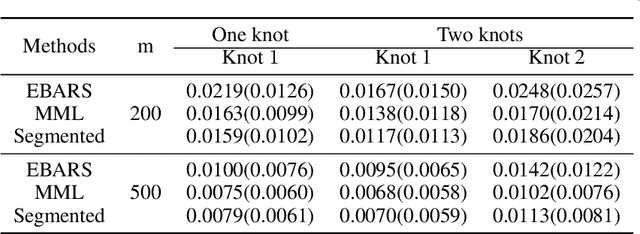
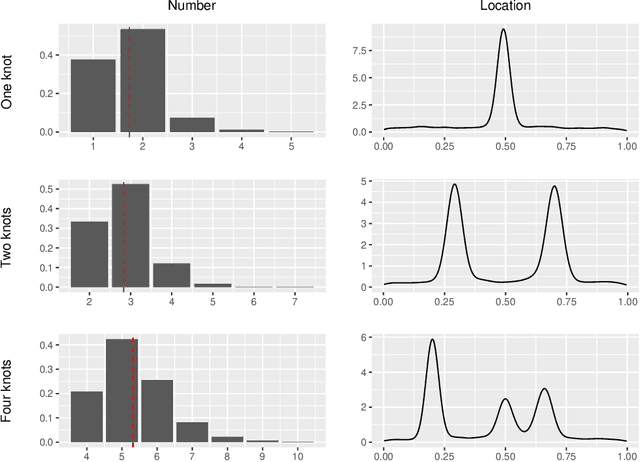

Abstract:In multivariate spline regression, the number and locations of knots influence the performance and interpretability significantly. However, due to non-differentiability and varying dimensions, there is no desirable frequentist method to make inference on knots. In this article, we propose a fully Bayesian approach for knot inference in multivariate spline regression. The existing Bayesian method often uses BIC to calculate the posterior, but BIC is too liberal and it will heavily overestimate the knot number when the candidate model space is large. We specify a new prior on the knot number to take into account the complexity of the model space and derive an analytic formula in the normal model. In the non-normal cases, we utilize the extended Bayesian information criterion to approximate the posterior density. The samples are simulated in the space with differing dimensions via reversible jump Markov chain Monte Carlo. We apply the proposed method in knot inference and manifold denoising. Experiments demonstrate the splendid capability of the algorithm, especially in function fitting with jumping discontinuity.
An Analysis of Switchback Designs in Reinforcement Learning
Mar 26, 2024Abstract:This paper offers a detailed investigation of switchback designs in A/B testing, which alternate between baseline and new policies over time. Our aim is to thoroughly evaluate the effects of these designs on the accuracy of their resulting average treatment effect (ATE) estimators. We propose a novel "weak signal analysis" framework, which substantially simplifies the calculations of the mean squared errors (MSEs) of these ATEs in Markov decision process environments. Our findings suggest that (i) when the majority of reward errors are positively correlated, the switchback design is more efficient than the alternating-day design which switches policies in a daily basis. Additionally, increasing the frequency of policy switches tends to reduce the MSE of the ATE estimator. (ii) When the errors are uncorrelated, however, all these designs become asymptotically equivalent. (iii) In cases where the majority of errors are negative correlated, the alternating-day design becomes the optimal choice. These insights are crucial, offering guidelines for practitioners on designing experiments in A/B testing. Our analysis accommodates a variety of policy value estimators, including model-based estimators, least squares temporal difference learning estimators, and double reinforcement learning estimators, thereby offering a comprehensive understanding of optimal design strategies for policy evaluation in reinforcement learning.
DomainVerse: A Benchmark Towards Real-World Distribution Shifts For Tuning-Free Adaptive Domain Generalization
Mar 05, 2024Abstract:Traditional cross-domain tasks, including domain adaptation and domain generalization, rely heavily on training model by source domain data. With the recent advance of vision-language models (VLMs), viewed as natural source models, the cross-domain task changes to directly adapt the pre-trained source model to arbitrary target domains equipped with prior domain knowledge, and we name this task Adaptive Domain Generalization (ADG). However, current cross-domain datasets have many limitations, such as unrealistic domains, unclear domain definitions, and the inability to fine-grained domain decomposition, which drives us to establish a novel dataset DomainVerse for ADG. Benefiting from the introduced hierarchical definition of domain shifts, DomainVerse consists of about 0.5 million images from 390 fine-grained realistic domains. With the help of the constructed DomainVerse and VLMs, we propose two methods called Domain CLIP and Domain++ CLIP for tuning-free adaptive domain generalization. Extensive and comprehensive experiments demonstrate the significance of the dataset and the effectiveness of the proposed methods.
Counterfactual Graph Transformer for Traffic Flow Prediction
Aug 01, 2023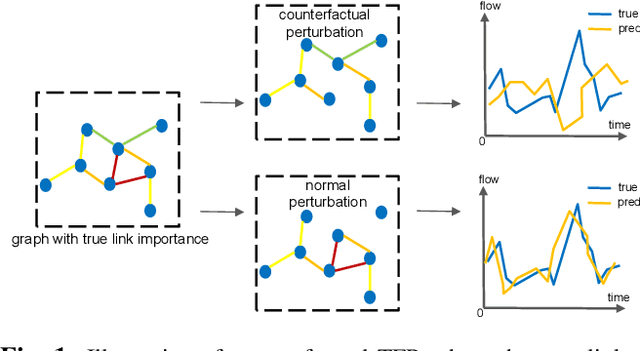
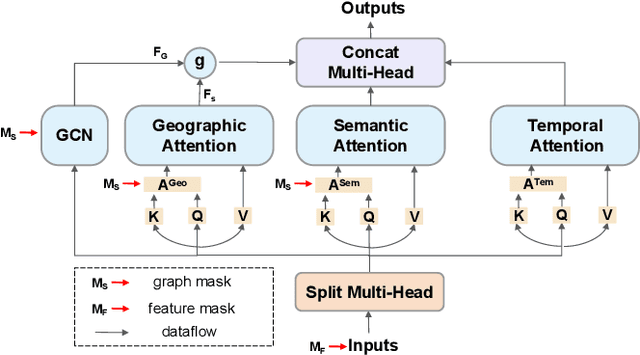
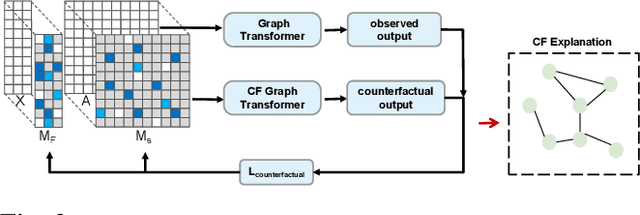
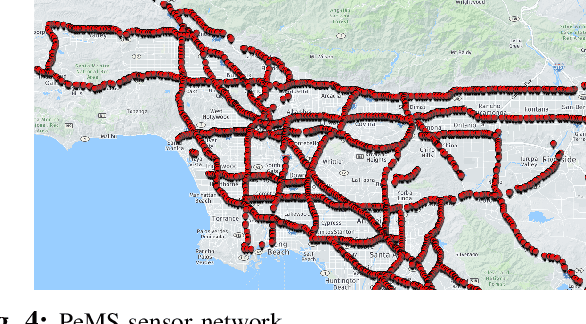
Abstract:Traffic flow prediction (TFP) is a fundamental problem of the Intelligent Transportation System (ITS), as it models the latent spatial-temporal dependency of traffic flow for potential congestion prediction. Recent graph-based models with multiple kinds of attention mechanisms have achieved promising performance. However, existing methods for traffic flow prediction tend to inherit the bias pattern from the dataset and lack interpretability. To this end, we propose a Counterfactual Graph Transformer (CGT) model with an instance-level explainer (e.g., finding the important subgraphs) specifically designed for TFP. We design a perturbation mask generator over input sensor features at the time dimension and the graph structure on the graph transformer module to obtain spatial and temporal counterfactual explanations. By searching the optimal perturbation masks on the input data feature and graph structures, we can obtain the concise and dominant data or graph edge links for the subsequent TFP task. After re-training the utilized graph transformer model after counterfactual perturbation, we can obtain improved and interpretable traffic flow prediction. Extensive results on three real-world public datasets show that CGT can produce reliable explanations and is promising for traffic flow prediction.
 Add to Chrome
Add to Chrome Add to Firefox
Add to Firefox Add to Edge
Add to Edge